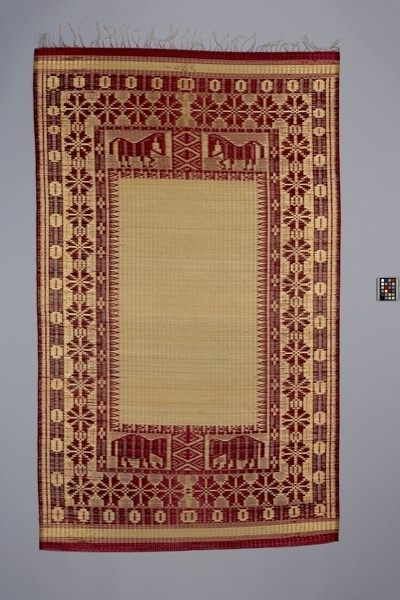Mat Item Number: Ef199 from the MOA: University of British Columbia

Description
Rectangular grass mat of fine regular weave. The mat has a large border around all sides in purple on a natural-coloured ground. The border has many bands ranging in thickness and motifs. The outer band has a geometric motif. The middle band has a floral motif. The band closest to the centre has a pair of elephants on one end and horses on the other, all facing inwards. The centre is without design. Long weaving threads are tied off at one end.
History Of Use
The antiquity of woven mats in India is supported by archaeological evidence and references in ancient texts. Mats are among the most important of household items in every strata of society. They are essential to most domestic activities and are used in sleeping, eating, sitting, and entertaining. The finest mats of West Bengal are woven of madur grass, grown and harvested by weavers of Hindu cultivator castes. This village-based industry is now assisted by the West Bengal Home Industry Board to establish cooperatives for mat transport and marketing.
Iconographic Meaning
Both the elephant, vehicle of Indra and associated with Ganesh, remover of obstacles, and the horse, are auspicious symbols and represent good luck.
Cultural Context
floor covering
Item History
- Made in Kholaberia, West Bengal, India before 1975
- Collected during 1975
- Owned by Stephen Inglis before December 2, 1977
- Received from Museum of Anthropology Donations Fund (Funding source) and Stephen Inglis (Seller) on December 2, 1977
What
Who
- Culture
- Bengali
- Previous Owner
- Stephen Inglis
- Received from
- Museum of Anthropology Donations Fund (Funding source) and Stephen Inglis (Seller)
Where
- Holding Institution
- MOA: University of British Columbia
- Made in
- Kholaberia, West Bengal, India
When
- Creation Date
- before 1975
- Collection Date
- during 1975
- Ownership Date
- before December 2, 1977
- Acquisition Date
- on December 2, 1977
Other
- Item Classes
- textiles; basketry
- Condition
- good
- Accession Number
- 0411/0080